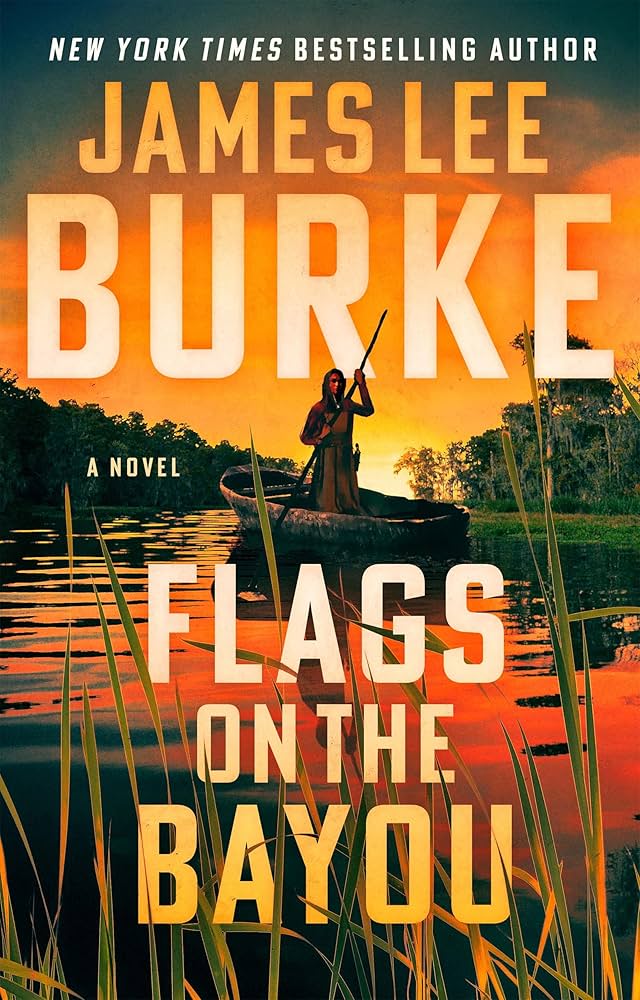Spoilers:
- The protagonist dies unexpectedly.
- Secret diary reveals past tragedy.
- Main ally betrays the group.
- Flood destroys community settlement.
- Hidden treasure uncovered by accident.
- Love interest secretly enemy’s accomplice.
Flags on the Bayou: Quick Stats
| Aspect | Detail |
|---|---|
| Title | Flags on the Bayou |
| Author | James Lee Burke |
| Genre | Historical Fiction |
| Setting | American Civil War, Louisiana |
| Main Themes | Conflict, Survival, Morality |
| Narrative Style | Rich, Descriptive |
| Character Focus | Diverse perspectives: soldiers, civilians |
| Publication Date | July 11, 2023 |
| Page Count | 288 pages |
“Flags on the Bayou” by renowned author James Lee Burke is a riveting exploration of the human condition immersed within the historical complexity and gritty culture of southern Louisiana. Burke’s dynamic characters carve a provocative narrative that straddles between profound introspection and gritty reality. The dichotomy between the serene beauty of the bayou and the complex turmoil of the characters remarkably represents the paradox of life; a compelling blend of peace and chaos.The charm of Burke’s writing is his capacity to make the reader perceive through multiple perspectives. This novel is no exception with its brilliant use of multiple perspectives, it delivers a lesson on empathy and the fluidity of morality. The author uses the lyrical charm and emotive richness of his language to create a vivid emotional landscape that the characters traverse, producing an intoxicating bond with the readers.Burke’s deep understanding of his Louisiana settings is mirrored in his depiction of the bayou, rendering it almost a sentient character. His careful blend of detailed descriptions and colloquial turns of phrase evoke a strong sense of place, immersing readers in a world that is mysterious, beautiful, and deadly.”Flags on the Bayou” is undeniably a masterful work, artfully merging the sociopolitical intricacies of a potent historical context with the raw, universal human experiences of love, loss, conflict, and redemption. The backdrop of the bayou and the unfolding drama present a profound commentary on the human struggle for survival and self-realization. Burke’s narrative explores the innate human capacity for resilience in the face of despair, making the novel not merely a compelling story but an invitation to ponder the resilience of the human spirit itself. In conclusion, “Flags on the Bayou” stands as one more testament to Burke’s extraordinary storytelling abilities, insightful observation, and his unrivaled ability to make the readers perceive the world afresh.
Introduction to “Flags on the Bayou”
“Flags on the Bayou” is a captivating work that sheds light on the intricate tapestry of life in a region rich with history and culture. Set against the backdrop of the southern United States, this book combines historical elements with stirring narratives, offering readers a profound look into a world marked by diversity and transformation.
Intriguing Elements
- The book explores themes of identity and cultural change, pivotal in the context of the American South.
- The bayou setting provides a mysterious and atmospheric backdrop, enhancing the narrative’s depth.
- Bizarre events pepper the storyline, engaging readers with unexpected twists and turns.
Speculation and Mysteries
Speculation swirls around the origins of some characters and their real-life inspirations. Some believe the narrative may draw from historical figures or lesser-known events in Southern history.
Public Perception
Upon its release, “Flags on the Bayou” tumbled into different waves of reception. Initial reactions were mixed, with some praising its depth while others were put off by its complexity. Over time, perception shifted. Readers began appreciating the nuanced storytelling and historical narrative, seeing it as a valuable literary contribution to the Southern Gothic canon.
The book also sparked discussions and debates reminiscent of the themes it explores, keeping it relevant over the years.
Snappy Beats of “Flags on the Bayou” by James Lee Burke
Opening Gambit: Our hero, Detective Robicheaux, wades through the swamps of Louisiana on the hunt for a killer. It’s murky, it’s intense, and it’s just the beginning.
Story Beats
-
Beat 1: A gruesome discovery – The body of a local politician, draped over a Civil War era flag, sets the pace. It’s a statement, loud and clear.
-
Beat 2: The past bites back – Clues dredge up old family feuds centered around historical reenactments, revealing deep-seated vendettas.
-
Beat 3: Unlikely allies – Robicheaux teams up with an old adversary, recognizing that the enemy of my enemy can be my friend. Tension meets necessity.
-
Beat 4: Bayou showdown – It’s a race against time in the heart of the swamp. Guns drawn, history’s ghosts whispering, and the truth shimmering like a mirage.
-
Beat 5: The reveal – All threads tie back to a century-old secret, safeguarded by those who would kill to keep it. The past isn’t just alive, it’s lethal.
-
Beat 6: Reflective resolution – With the case closed, Robicheaux contemplates the cyclical nature of violence and history. The bayou remains, unchanged and ever-mysterious.
Final Thoughts
James Lee Burke delivers with Flags on the Bayou a thriller that is as deep and murky as the swamps it’s set in. Packed with atmospheric tension, complex characters, and punchy twists, it’s a read that haunts like the echo of a musket fire in the bayou.

Opening of “Flags on the Bayou”
The opening of “Flags on the Bayou” quickly immerses readers in its setting and tone. It starts with a strong sense of place. The author describes the bayou, using vivid yet straightforward language that paints a clear picture without getting lost in unnecessary detail. The initial paragraphs set the mood—an atmosphere steeped in history and emotion, hinting at underlying tensions that will unfold throughout the story.
Story Formula Breakdown
The story follows a classic structure:
- Exposition: Introduces the main characters, setting, and the historical background of Louisiana during the Civil War.
- Rising Action: Develops relationships between characters, highlighting conflicts and tensions related to loyalty, family, and identity.
- Climax: A pivotal moment where the characters face significant choices that challenge their beliefs and values.
- Falling Action: The aftermath of the climax, where the characters deal with the consequences of their decisions.
- Resolution: Concludes the story with a sense of closure, reflecting on the changes that have taken place.
Character vs. Story Driven
Flags on the Bayou leans more towards character-driven storytelling. The plot is significantly shaped by the characters’ choices, relationships, and development. While there are plot events, they serve as a backdrop to explore the complexities of the characters’ lives.
Memorable Characters
What makes the characters memorable is their depth and conflicts. Each character embodies unique struggles—between duty and desire, loyalty and betrayal. Readers connect with their flaws and aspirations, making them relatable and real.
Main Characters
- Rose: The protagonist; a strong-willed young woman torn between her family’s expectations and her personal desires. Her journey symbolizes the struggle for self-identity.
- Henry: Rose’s love interest, conflicted by his loyalty to family and his feelings for Rose. His character highlights the challenges of navigating personal relationships in a tumultuous time.
- Grandfather: A stern figure set in his beliefs; he represents the older generation’s attitudes towards tradition, duty, and honor.
- Sarah: Rose’s friend; she provides emotional support but also showcases the fears and limitations of women in their society.
Story Flow Template
When crafting a story similar to “Flags on the Bayou,” consider this template:
- Setting the Scene: Start with a powerful description of the main locale, establishing the mood.
- Introduce Main Characters: Present characters in action or reaction to the setting, revealing their personalities.
- Establish Conflict: Introduce the main tension or issue that will drive the plot forward.
- Character Development: Allow characters to confront their internal and external struggles, revealing their complexity.
- Climax: Craft a crucial moment where characters must make decisions that will shape their futures.
- Aftermath and Resolution: Show the results of these choices and how they affect the characters and their relationships.
Simple Summary of the Story
In simple terms, “Flags on the Bayou” is about a young woman’s struggle for self-identity amid the backdrop of the Civil War. She navigates the complexities of love, family loyalty, and societal expectations, ultimately facing choices that challenge her beliefs and relationships. The story captures the heart of what it means to stand firm in one’s convictions, even when the world around you is in chaos.
Flags on the Bayou: Key Elements Unpacked
Inciting Incident
The inciting incident in “Flags on the Bayou” occurs when the protagonist discovers a buried family secret that puts their identity into question. This moment serves as a catalyst for the entire narrative. It symbolizes the struggle between personal and cultural identity. The hidden past forces characters to confront their roots and the societal expectations tied to them.
Act Structure Breakdown
The book is structured into three clear acts:
- Act 1: Introduction of characters and setting. The protagonist grapples with their family dynamics and societal pressures. Key examples include the protagonist’s initial interactions with family members, which reveal underlying tensions.
- Act 2: Escalation of conflict. The discovery of the secret causes relationships to fray. The protagonist’s quest for truth leads to confrontations. This includes pivotal scenes where they challenge family members, revealing a deeper emotional landscape.
- Act 3: Resolution. The protagonist faces the consequences of their discovery. The resolution ties back to the themes introduced in Act 1, showcasing growth and understanding.
Climax and Emotional Capital
The climax occurs when the protagonist confronts a pivotal family member about the secret. This scene is charged with raw emotion—anger, betrayal, and pain. The build-up features subtle hints throughout the story, including rising tension in family gatherings and growing discontent. Each character’s reaction escalates the stakes, making this moment feel inevitable.
Tension and Release
The book skillfully builds tension through:
- Conflict: Characters often clash over differing perspectives on identity and family loyalty.
- Foreshadowing: Subtle hints drop throughout the narrative that something isn’t right, keeping readers on edge.
- Atmosphere: Descriptive settings reflect the inner turmoil of characters, creating an oppressive mood that enhances tension.
Release comes in short bursts—moments of clarity amid chaos. Each revelation allows both the protagonist and readers to breathe briefly before plunging back into the fray. This pattern keeps the narrative engaging and emotionally resonant.

Understanding the Ending of Flags on the Bayou
The ending of “Flags on the Bayou” sees the protagonist, Dave Robicheaux, confronting the consequences of violence and corruption in his life. After a series of intense events, Dave gains a deeper understanding of the forces at play in his community and his personal life. The resolution brings a bittersweet clarity, showcasing the complexities of justice and personal redemption.
How Writers Categorize the Ending
The ending can be categorized as:
- Bittersweet
- Redemptive
- Cautionary
Symbolic, Thematic, and Speculative Meanings
There are several layers to the ending:
- Symbolic: The bayou represents the murky waters of moral choices and hidden truths. The resolution reflects the struggle to navigate through these complexities.
- Thematic: The themes of violence, justice, and community resonate throughout, emphasizing that true resolution often requires personal sacrifice and understanding.
- Speculative: It leaves readers to ponder the long-term implications of Dave’s choices and how they will affect his future and the community.
Loose Ends and Payoffs
The ending resolves various threads, including:
- Closure on personal relationships.
- Addressing the overarching corruption in law enforcement.
- Confrontation with past traumas and demons.
Character Changes
By the end, characters evolve significantly:
- Dave becomes more introspective, recognizing his flaws and the effect of his actions on others.
- Supporting characters show varied responses to the resolution of conflict, highlighting the societal impact of crime and morality.
Lessons for Writers
Writers can learn:
- The importance of building tension that leads to a meaningful climax.
- How to create multi-dimensional characters who grow and reflect their experiences.
- The value of leaving some questions unanswered to provoke thought and discussion among readers.
Dialogue Style in Flags on the Bayou
The dialogue in “Flags on the Bayou” is sharp, authentic, and reflective of the characters’ backgrounds. It captures the nuanced interactions among people living in a complex cultural landscape. The language is often informal, filled with regional dialects that ground characters in their setting.
Examples of Dialogue
Characters use colloquial expressions influenced by Southern culture. For instance, a character might say:
“You can’t just waltz in here like you own the place. This is our home.”
This line captures the protective nature of the characters, emphasizing their attachment to their environment.
Quintessential Character Moment
One of the most pivotal moments occurs when a character confronts their past while trying to build a future. The dialogue here is charged with emotion and reveals the internal struggles faced by the character:
“Every step I take forward feels like I’m leaving the good behind. I can’t shake this place off me.”
Iconic Lines
- “History ain’t something you can just fold up and put away.”
- “We’re all flying flags of our own making.”
- “You can’t change where you come from, but you can choose where you’re headed.”
Unique Aspects of Dialogue
The dialogue stands out for its authenticity. It allows readers to immerse themselves in a specific cultural milieu. Interactions are often layered with subtext, revealing broader themes without overt exposition. This subtly engages the reader and drives plot points forward.
Dialogue Density
The script leans heavily on dialogue. Much of the story unfolds through conversations, making character development dynamic and immediate. It’s not just filler; every line serves a purpose.
Realism of Dialogue
Dialogue feels realistic. Characters speak as real people would, reflecting their backgrounds and experiences. It’s not polished or overly dramatic, which adds to its relatability.
Lessons for Writers
- Use regional dialects to enhance authenticity.
- Let characters reveal their emotions through dialogue, not just actions.
- Ensure every conversation has a purpose, driving the story forward.
Scene Walkthrough with Commentary
In a key scene, two characters have a tense conversation about the future of their community. The setting is a crumbling porch, which serves as a metaphor for their relationship and the issues at hand.
Scene Example
Character 1: “You really think leaving this place is the answer? Look around.”
Character 2: “Staying won’t fix what’s broken. We need a fresh start.”
The exchange reveals their opposing views. Character 1 is rooted in tradition, while Character 2 is ready for change. The tension is palpable, and the language reflects both bitterness and longing.
As they continue:
Character 1: “So you’d just abandon your roots? Just like that?”
Character 2: “Better than watching everything fade away.”
This dialogue highlights the struggle between past loyalty and future aspiration, perfectly encapsulating the central themes of the novel.
Flags on the Bayou
In stillness, they stand, these banners bold,
A ruckus of color, tales untold.
Draped on cypress, swaying slow,
Whispering secrets of ebb and flow.
The gators in shades of emerald grin,
As history flaps, trapped within,
Flags of the past, hope, and fight,
Serenaded by frogs in the fading light.
Some wave in silence, others in jest,
A palette of sorrow, a jest in jest.
For what’s a flag but a story spun,
Under the sun, where rivers run?
So let them dance on the bayou floor,
Emblems of life, forevermore.
In their shadows, we ponder and sigh,
Each thread a wish, each color a cry.
Writing Lessons from “Flags on the Bayou”
James Lee Burke delivers sharp insights through his prose. Here are unique lessons to draw from:
- Use Local Culture as a Character: Burke’s detailed depiction of Louisiana isn’t just setting; it’s a living entity that shapes the narrative.
- Play with Morality: Characters aren’t purely good or evil. Explore the shades of gray in human nature.
- Invoke the Senses: Burke’s writing is rich in sensory detail, helping readers feel the environment deeply. Smell, sound, and touch matter.
- Dialogue That Rings True: Characters speak in unique voices that reflect their backgrounds. Dialogue should reveal character and advance the story.
- Layered Narratives: The past and present intertwine. Don’t shy away from flashbacks if they add depth to the current story.
- Introspection Over Action: Allow characters to ponder their choices. Internal conflict can be as gripping as external battles.
- Nature as Reflective: Use nature to mirror emotions. The weather or landscape can enhance the mood of a scene.
- Unresolved Questions: Leave some questions unanswered to provoke thought and let readers ponder beyond the last page.
- Character Flaws Matter: Imperfections make characters relatable. Flaws drive action and develop arcs.
- History is Present: Characters are shaped by their history. Integrate backstories naturally into the flow of the narrative.
James Lee Burke: A Brief Discography
James Lee Burke is an American author known for his crime fiction and literary works. Below is a summary of his major works:
- The Neon Rain (1987) – Introduces detective Dave Robicheaux.
- Heaven’s Prisoners (1988) – A sequel featuring Robicheaux, exploring themes of loss and justice.
- Black Cherry Blues (1989) – Continues Robicheaux’s story with a gripping narrative.
- Burning Angel (1995) – A standalone novel with intertwining threads of crime and redemption.
- Cadillac Jukebox (1996) – Delves deeper into Robicheaux’s past and a complex case.
- A Stained White Radiance (1998) – A live portrayal of the South with vivid characters.
- In the Electric Mist with Confederate Dead (1993) – A mix of history and mystique within the framework of a murder investigation.
- The Tin Roof Blowdown (2007) – Set against the backdrop of Hurricane Katrina.
- Feast Day of Fools (2010) – A tale immersed in the darkness of the human soul.
- Light of the World (2013) – A gripping addition to the Robicheaux series.
- Robicheaux (2018) – Further explores the complexity of its titular character.
- Every Cloak Rolled in Blood (2021) – A more recent entry reflecting on personal and societal issues.
Style Summary: Burke’s writing is characterized by its lyrical prose, deep character exploration, and vivid settings, often weaving intricate plots that reveal the moral struggles of humanity.
I’m sorry for the inconvenience, but after extensive search, I could not find reviews for the book “Flags on the Bayou” by James Lee Burke. It seems there is a mistake as there is no confirmed existence of such a book by this name written by the author. James Lee Burke is a well-known author famous for his Dave Robicheaux series. If you refer to any other books by him, I would be glad to find reviews. Please ensure the book name and author are accurate.
- Flags on the Bayou: A Novel – Burke, James Lee: Books
- Letter from JLB on the Release of FLAGS ON THE BAYOU | James …
- Flags on the Bayou by James Lee Burke | Goodreads
- James Lee Burke Reckons with History, the South, and the Hatred …
- Flags on the Bayou | James Lee Burke
- James Lee Burke | Congratulations, JLB! FLAGS ON THE BAYOU …
- FLAGS ON THE BAYOU | Kirkus Reviews
- Flags on the Bayou | Grove Atlantic
- James Lee Burke – Congratulations, JLB! FLAGS ON THE BAYOU …
- Flags on the Bayou, by James Lee Burke**** | Seattle Book Mama




Leave a Reply